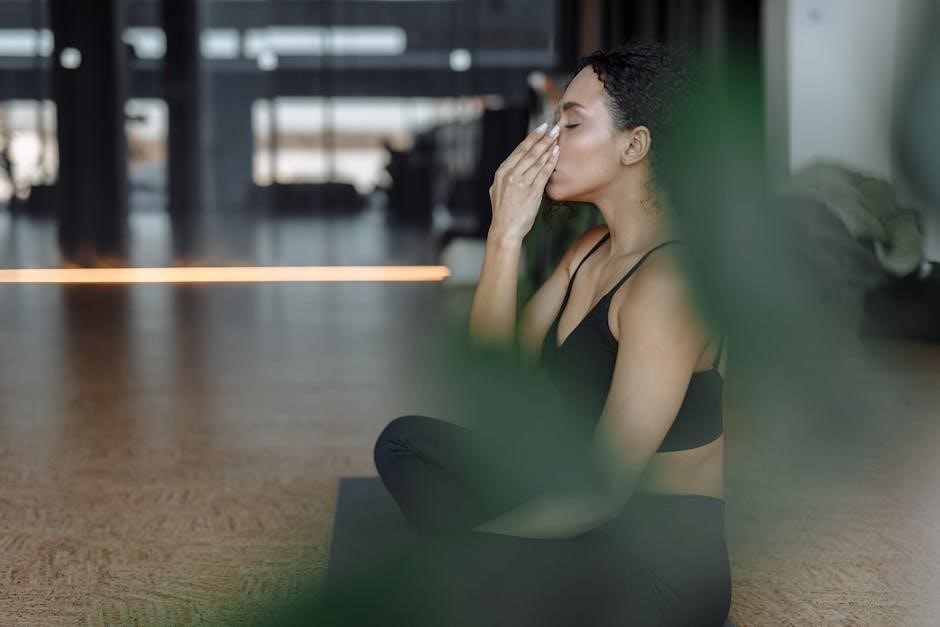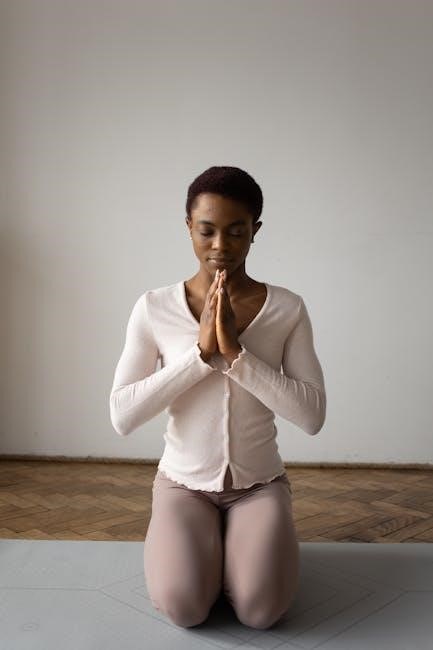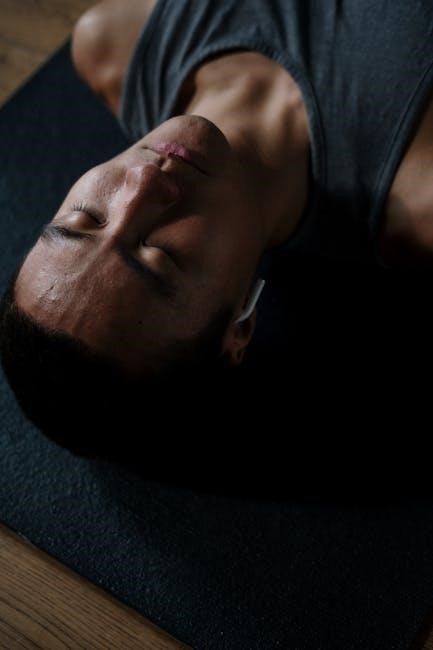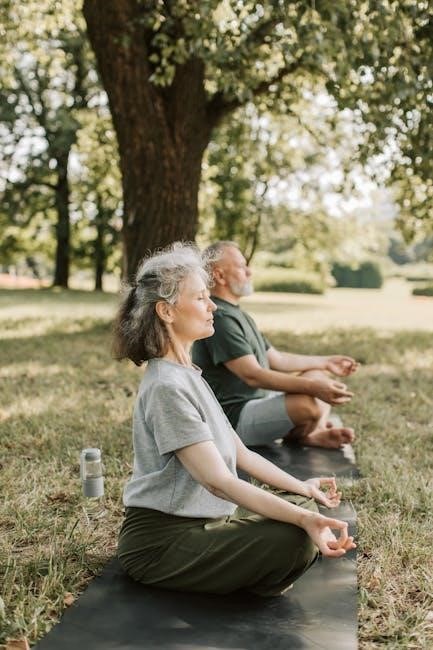The Buteyko Breathing Method, developed by Dr. Konstantin Buteyko, is a holistic approach focusing on nasal breathing and breath control to normalize respiratory patterns and improve health. It emphasizes reduced breathing exercises, breath-holding techniques, and natural CO2 regulation to enhance oxygen delivery and reduce respiratory issues like asthma. This method, supported by clinical studies, offers a drug-free alternative for managing breathing disorders and promoting overall well-being through simple, consistent practice.
Overview of the Buteyko Breathing Technique
The Buteyko Breathing Technique is a respiratory method developed by Dr. Konstantin Buteyko that focuses on normalizing breathing patterns through nasal breathing, breath-holding exercises, and conscious breath control. It aims to reduce hyperventilation and restore natural CO2 levels, which are essential for proper oxygen delivery and metabolic balance. The technique emphasizes gentle, shallow breathing through the nose, avoiding deep or rapid breathing, which can disrupt respiratory function. Practitioners use exercises like the control pause and reduced breathing to gradually improve lung capacity and overall health. This method is particularly beneficial for individuals with asthma, anxiety, and other respiratory conditions, offering a drug-free approach to managing symptoms and enhancing well-being. The Buteyko Breathing Technique is often practiced alongside lifestyle changes, such as dietary adjustments and stress management, to maximize its benefits and promote long-term health.
History and Development of the Buteyko Method
The Buteyko Breathing Method was first developed in the 1960s by Russian physician Dr. Konstantin Pavlovich Buteyko. Initially, Dr. Buteyko observed that shallow breathing could improve respiratory function and overall health. He formulated the technique based on his research into the role of carbon dioxide (CO2) in respiratory health, proposing that reduced breathing could normalize CO2 levels and enhance oxygen delivery to tissues. The method gained popularity in the Soviet Union and later spread globally, with clinical trials and anecdotal evidence supporting its effectiveness for asthma, anxiety, and other respiratory conditions. Dr. Buteyko’s work was influenced by his own health struggles and experiments on himself and patients. Over time, the technique has evolved, incorporating various exercises like the control pause and breath-holding practices. Today, the Buteyko Method is recognized worldwide as a natural, non-invasive approach to improving respiratory health and overall well-being.
Core Principles of the Buteyko Breathing Technique
The Buteyko Breathing Technique focuses on nasal breathing, breath holding, and reduced breathing volume to normalize CO2 levels, enhancing oxygen delivery and promoting respiratory balance for improved health and well-being.
The Role of Nasal Breathing in Buteyko
Nasal breathing is a cornerstone of the Buteyko Breathing Technique, emphasizing the importance of breathing through the nose rather than the mouth. This natural process conditions the air, warming, humidifying, and filtering it, which protects the lungs and maintains respiratory health. Nasal breathing also engages the body’s innate mechanisms to regulate carbon dioxide (CO2) levels, crucial for proper oxygen delivery to tissues and cells. By prioritizing nasal breathing, the technique aims to restore normal respiratory patterns, reducing over-breathing and promoting a balanced physiological state. Practitioners are encouraged to practice nasal breathing during both wakefulness and sleep, often using techniques like nasal strips or tape to prevent mouth breathing at night. This approach is believed to enhance overall respiratory efficiency and improve conditions such as asthma and hyperventilation syndrome.
Importance of Breath Holding and Reduced Breathing
Breath holding and reduced breathing are central to the Buteyko Method, designed to normalize respiratory patterns and optimize CO2 levels in the body. By temporarily holding the breath, individuals can increase carbon dioxide concentration, which enhances oxygen delivery to tissues and improves respiratory function. Reduced breathing exercises teach the body to adopt shallower, more efficient breathing, preventing hyperventilation and its associated symptoms. These practices are particularly beneficial for conditions like asthma, where over-breathing can exacerbate symptoms. Regular implementation of these techniques helps restore natural breathing rhythms, promoting better health and reducing reliance on medication. The method emphasizes gradual practice, ensuring comfort and safety while fostering long-term respiratory balance.

Key Buteyko Breathing Exercises
The Buteyko Method includes exercises like the Control Pause, walking with breath holding, and step exercises, all focusing on nasal breathing and breath control to improve respiratory efficiency and overall health.
Control Pause Exercise
The Control Pause (CP) is a cornerstone of the Buteyko Breathing Method, designed to measure and improve breath control. It involves exhaling gently, pinching the nose, and holding the breath until a slight air hunger is felt. The duration of this pause reflects current respiratory health. Longer pauses indicate better CO2 tolerance and breathing efficiency. Regular practice enhances respiratory function, reduces asthma symptoms, and alleviates anxiety. Instructions include exhaling softly, holding the breath, and resuming slow nasal breathing. The exercise is recommended 2-4 times daily, adapting as comfort allows. Over time, increased CP durations signify progress in normalizing breathing patterns and improving overall health. This simple yet effective technique is widely used in Buteyko practice to promote sustainable respiratory well-being.
Walking Exercises with Breath Holding
Walking exercises with breath holding are a key component of the Buteyko Breathing Method, designed to enhance respiratory control and improve overall breathing efficiency. These exercises involve walking while holding the breath for a specific number of steps or seconds, followed by a return to slow, nasal breathing. The technique begins with short breath holds, gradually increasing in duration as comfort and CO2 tolerance improve. Regular practice helps reduce over-breathing, strengthens respiratory muscles, and enhances oxygen delivery to tissues. This method is particularly beneficial for managing asthma, reducing stress, and improving physical endurance. By combining gentle physical activity with controlled breathing, individuals can experience significant improvements in respiratory function and overall well-being. The exercises are simple, effective, and can be integrated into daily routines for sustained health benefits.
Step Exercises for Breath Control
Step exercises for breath control are a fundamental part of the Buteyko Breathing Method, designed to enhance respiratory efficiency and overall well-being. These exercises involve walking a specific number of steps while holding the breath, followed by a period of relaxed nasal breathing. The practice begins with shorter breath holds, gradually increasing as tolerance improves. By limiting breathing volume and slowing down the respiratory rate, these exercises help normalize CO2 levels in the blood, which is essential for proper oxygen delivery and metabolic balance; Regular practice strengthens the respiratory system, improves lung function, and reduces symptoms of asthma and other breathing disorders. The step exercises also promote mental focus and relaxation, making them a versatile tool for both physical and emotional health. Over time, they help restore natural breathing patterns, leading to better energy levels and a reduced need for medication in managing respiratory conditions.

Benefits of the Buteyko Breathing Method
The Buteyko Breathing Method offers significant health benefits, including improved asthma management, reduced anxiety, and enhanced sleep quality. It promotes natural breathing patterns, boosting energy and overall well-being.
Improvements in Asthma Management
The Buteyko Breathing Method has shown significant promise in improving asthma management by reducing symptoms such as wheezing, coughing, and shortness of breath. By focusing on nasal breathing and breath control, the technique helps normalize breathing patterns, reducing over-breathing and hyperventilation. This approach increases carbon dioxide levels in the blood, which can improve oxygen delivery to the lungs and reduce airway constriction. Studies, such as the 2003 trial published in Thorax, demonstrate that Buteyko breathing can lead to a reduction in asthma medication use and improved quality of life for patients. The method also emphasizes breath-holding exercises, like the Control Pause, which helps desensitize the airways and reduce bronchospasm. Many users report fewer asthma attacks and improved lung function, making the Buteyko Method a valuable complementary therapy for asthma management.
Reduction of Anxiety and Panic Attacks
The Buteyko Breathing Method has been widely recognized for its ability to reduce anxiety and panic attacks by promoting calm and balanced breathing. The technique emphasizes gentle, shallow nasal breathing, which helps stabilize carbon dioxide levels in the blood. This prevents hyperventilation, a common trigger for anxiety and panic attacks. By practicing exercises like the Control Pause, individuals can gradually increase their tolerance to carbon dioxide, reducing the frequency and intensity of anxiety episodes. Many users report feeling more grounded and less prone to panic after incorporating Buteyko breathing into their daily routines. The method’s focus on breath control provides a practical tool for managing stress and anxiety in real-time, making it a valuable complement to traditional therapies. Studies and user experiences highlight its effectiveness in fostering emotional stability and improving overall mental well-being.
Enhanced Sleep Quality Through Nasal Breathing
Practicing the Buteyko Breathing Method can significantly improve sleep quality by promoting consistent nasal breathing. This technique helps regulate breathing patterns, reducing erratic or shallow breathing that often disrupts sleep. By focusing on gentle, controlled breaths through the nose, individuals can enhance oxygenation and carbon dioxide levels, leading to more restful and deeper sleep. Many practitioners report reduced instances of sleep apnea, snoring, and restless nights. The method also encourages the use of nasal strips or tape to prevent mouth breathing during sleep, further ensuring uninterrupted nasal breathing. Regular practice of Buteyko exercises can help establish a stable respiratory rhythm, making it easier to fall asleep and stay asleep. This approach not only improves sleep quality but also contributes to overall physical and mental rejuvenation, making it a valuable tool for those seeking better rest and recovery.

Scientific Evidence and Studies
The Buteyko Breathing Method is supported by clinical trials, such as a 2003 study in Thorax, showing its effectiveness in reducing asthma symptoms and bronchodilator use. Research highlights its benefits for respiratory conditions by improving CO2 levels and breathing normalization.
Clinical Trials on Buteyko Breathing for Asthma
Clinical trials, such as the 2003 study published in Thorax, demonstrate the Buteyko Breathing Method’s efficacy in reducing asthma symptoms and bronchodilator use. The study revealed that participants practicing Buteyko techniques experienced significant improvements in asthma control, with reduced bronchial hyperresponsiveness. Another trial highlighted the method’s ability to enhance lung function and decrease medication dependency. These findings suggest that Buteyko breathing can be a valuable adjunct to conventional asthma management, offering a drug-free approach to symptom relief. The method’s focus on nasal breathing and breath control helps normalize CO2 levels, improving oxygen delivery and reducing hyperventilation, which are often underlying issues in asthma. With consistent practice, many individuals report long-term benefits, making it a promising complementary therapy for respiratory health.
Comparison with Other Breathing Techniques
The Buteyko Breathing Method stands out among other techniques due to its focus on nasal breathing and breath-holding exercises to regulate CO2 levels. Unlike methods such as pranayama or diaphragmatic breathing, Buteyko emphasizes reduced breathing volume and controlled pauses. This approach aims to prevent hyperventilation and restore normal respiratory patterns. Studies comparing Buteyko with pranayama show similar benefits in asthma management, though Buteyko’s structured exercises may offer more consistent results. While techniques like box breathing focus on stress reduction, Buteyko addresses both stress and respiratory health by improving body-oxygen levels. Its unique blend of breath control and nasal breathing makes it a distinctive and effective option for managing asthma and other respiratory conditions, setting it apart from more generalized breathing practices.
Buteyko Breathing PDF Guide
The Buteyko Breathing PDF Guide provides a comprehensive manual on mastering the technique, offering structured exercises, practical tips, and essential background to help users understand and implement the method effectively for improved respiratory health.
Structure and Content of the Buteyko Breathing Manual
The Buteyko Breathing Manual is a well-organized guide that begins with an introduction to the method’s history and principles. It then progresses to detailed explanations of core techniques, such as nasal breathing, breath-holding exercises, and reduced breathing practices. The manual includes step-by-step instructions for various exercises, including the Control Pause, walking exercises with breath holding, and step exercises for breath control. Additionally, it provides practical tips for incorporating Buteyko breathing into daily life, such as practicing during sleep and managing stress. Advanced sections offer specialized exercises for specific health conditions and ways to combine Buteyko with other therapies. The manual also includes scientific evidence and studies supporting the method’s effectiveness, making it a comprehensive resource for both beginners and advanced practitioners. Overall, the guide is designed to empower users with the knowledge and tools needed to improve their respiratory health and overall well-being through consistent practice.
Practical Tips for Implementing the Technique
Implementing the Buteyko Breathing Method requires consistency and awareness. Start by practicing nasal breathing exclusively, even during sleep, using nasal strips or tape if needed. Incorporate daily exercises like the Control Pause, breath-holding while walking, and step exercises. Begin with short sessions of 10-15 minutes, gradually increasing frequency to 3-4 times a day. Track progress using a Buteyko Practice Diary to monitor improvements in breath control and overall health. Avoid overexertion and ensure breath holds are comfortable, not stressful. Use the Control Pause to calm anxiety or panic by exhaling gently, pinching the nose, and holding breath for a few seconds before resuming slow nasal breathing. For asthma, focus on shallow, slow breathing to prevent over-breathing. Maintain a balanced diet, avoid triggers, and consult a healthcare professional before adjusting medication. Regular practice and patience are key to mastering the technique and achieving long-term benefits.

Advanced Buteyko Breathing Techniques
Advanced techniques involve specialized exercises for specific health conditions, such as anxiety or chronic obstructive pulmonary disease (COPD), and combine Buteyko breathing with other therapies for enhanced benefits.
Exercises for Specific Health Conditions
The Buteyko Breathing Method offers tailored exercises for various health conditions, ensuring personalized benefits. For asthma, the focus is on controlled, shallow nasal breathing to prevent over-breathing and stabilize airway function. In cases of anxiety or panic attacks, techniques like the Control Pause help regain calm by gently exhaling, pinching the nose, and holding the breath for a few seconds before resuming slow nasal breathing. For chronic conditions such as COPD, exercises are adapted to improve lung capacity and reduce breathlessness. Specific routines include holding the breath for counts of 5 while walking or performing step exercises with breath holds of 10 paces, followed by nasal breathing. These exercises are designed to desensitize the body to breathlessness and enhance overall respiratory efficiency. Regular practice, ideally 2-4 times daily, is recommended to maximize results and adapt to individual needs. This structured approach ensures that the Buteyko Method addresses diverse health challenges effectively.
Combining Buteyko with Other Therapies
Combining the Buteyko Breathing Method with other therapies can enhance its effectiveness and address a wide range of health conditions. For instance, integrating Buteyko with yoga or mindfulness practices can deepen relaxation and improve respiratory control. Physical therapy, especially for conditions like COPD, can be complemented by Buteyko exercises to strengthen lung function and reduce breathlessness. Additionally, the method can be paired with halotherapy, where breathing salt aerosols supports respiratory health. Studies suggest that combining Buteyko with medical treatments for asthma or anxiety can lead to better symptom management and reduced medication reliance. The adaptability of Buteyko allows it to be incorporated into diverse therapeutic regimens, making it a versatile tool for holistic health. This integrative approach ensures that individuals can tailor their treatment plans to meet specific needs, maximizing the benefits of the Buteyko technique while addressing underlying health challenges effectively.

Real-World Applications of Buteyko Breathing
The Buteyko Breathing Method is widely applied to manage asthma, reduce anxiety, and improve sleep quality. It is also used by athletes to enhance endurance and by individuals for daily stress relief through consistent practice.
Using Buteyko for Daily Stress Relief
The Buteyko Breathing Method offers a powerful tool for managing daily stress and anxiety. By focusing on slow, nasal breathing and controlled breath-holding exercises, individuals can calm their nervous system and reduce stress hormones. This technique helps restore balance to the body’s carbon dioxide levels, which often become disrupted during periods of tension. Regular practice of Buteyko exercises can lead to improved emotional regulation, enhanced relaxation, and a greater sense of control over stressful situations. Many practitioners incorporate these breathing exercises into their daily routines, such as during work breaks or before sleep, to maintain mental clarity and reduce overwhelm. The method’s simplicity and accessibility make it an ideal complement to other stress-relief practices, providing a natural and effective way to manage the challenges of modern life.
Buteyko Breathing During Physical Activity
The Buteyko Breathing Method is highly effective when applied during physical activity, enhancing endurance and reducing breathlessness. By practicing nasal breathing and controlled breath-holding exercises, individuals can optimize their respiratory patterns, improving oxygen delivery to muscles. This technique helps maintain balanced CO2 levels, preventing over-breathing and excessive gasping for air. Many athletes and fitness enthusiasts incorporate Buteyko exercises into their routines, such as holding breath for short periods during walking or running, to build tolerance and stamina. The method also reduces the risk of hyperventilation, common during intense workouts, by promoting slower, deeper breathing. Regular practice of Buteyko breathing during physical activity not only improves performance but also enhances overall respiratory health, making it a valuable tool for anyone seeking to elevate their fitness and well-being.
